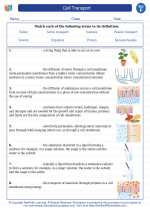Tissue Repair
Tissue repair is the process by which the body replaces damaged or dead cells. It is an essential mechanism for maintaining the integrity and function of tissues and organs.
Types of Tissue Repair
There are two main types of tissue repair: regeneration and fibrosis.
- Regeneration: Regeneration is the process by which damaged tissues are replaced by the same type of cells. This type of repair is common in tissues with high mitotic activity, such as the skin, liver, and bone marrow.
- Fibrosis: Fibrosis is the process by which damaged tissues are replaced by fibrous connective tissue, leading to the formation of scar tissue. This type of repair occurs in tissues with limited regenerative capacity, such as the heart and kidneys.
Steps of Tissue Repair
The process of tissue repair can be divided into several stages:
- Inflammation: When tissue is damaged, the body initiates an inflammatory response to remove debris and pathogens, and to prepare the damaged area for repair.
- Proliferation: During this stage, new cells are generated to replace the damaged ones. This involves cell division, migration, and differentiation of various cell types.
- Remodeling: In the final stage of tissue repair, the newly formed tissue undergoes remodeling to restore its structure and function. This may involve the removal of excess scar tissue and the reorganization of extracellular matrix components.
Factors Affecting Tissue Repair
Several factors can influence the process of tissue repair, including:
- Age: Young individuals generally have a more efficient and robust tissue repair capacity compared to older individuals.
- Nutrition: Adequate nutrition is essential for supporting the energy and building blocks required for tissue repair.
- Health Conditions: Chronic diseases, such as diabetes and autoimmune disorders, can impair tissue repair.
- External Factors: Environmental factors, such as exposure to toxins or radiation, can impact tissue repair processes.
Study Guide
Here are some key points to focus on when studying tissue repair:
- Understand the difference between regeneration and fibrosis, and the types of tissues where each type of repair occurs.
- Learn the stages of tissue repair: inflammation, proliferation, and remodeling.
- Identify the factors that can influence tissue repair, and understand how they can impact the process.
- Study specific examples of tissue repair in different organs and tissues.
- Explore current research and advancements in the field of tissue repair and regenerative medicine.
By understanding the mechanisms and factors involved in tissue repair, you can gain insights into the body's remarkable ability to heal and regenerate damaged tissues.
.◂Science Worksheets and Study Guides Sixth Grade. Cell Transport
Worksheet/Answer key Cell Transport
Cell Transport  Worksheet/Answer key
Worksheet/Answer key Cell Transport
Cell Transport  Vocabulary/Answer key
Vocabulary/Answer key Cell Transport
Cell Transport  Vocabulary/Answer key
Vocabulary/Answer key Cell Transport
Cell Transport 

 Worksheet/Answer key
Worksheet/Answer key
 Vocabulary/Answer key
Vocabulary/Answer key
 Vocabulary/Answer key
Vocabulary/Answer key

The resources above cover the following skills:
Reading Standards for Literacy in Science and Technical Subjects
Craft and Structure
Determine the meaning of symbols, key terms, and other domain-specific words and phrases as they are used in a specific scientific or technical context relevant to grades 6-8 texts and topics.